Our Land Overall …..
Welcome sign to Chambers Flat. Entry into our property of five acres of land is past two very big upright posts and an old timber cattle gate I retrieved for nothing when they closed the Cannon Hill Cattle Yards in the early 1980’s.
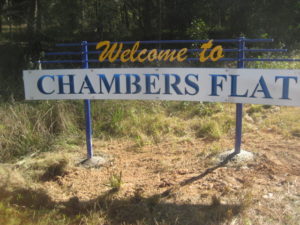
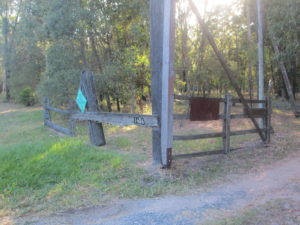
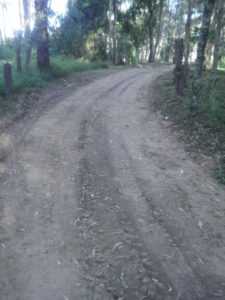
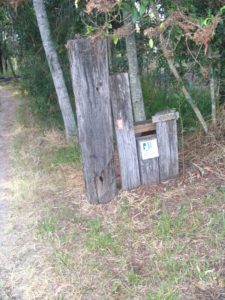
The letterbox is built out of upended old timber railway sleepers ….. it has a big sheet metal letterbox that was built for an old landscape job I was constructing in 1979. The client rejected it as she didn’t find it satisfactory for her suburban site. I reused it on our site and have been in good use on our site for 32 years up to 2021. The initial entry leads down our earth driveway to our house.
HISTORY: 1977 to 2021
We live in a special house built largely of demolition timber and stone, built forty years ago in 1981 for a fraction of the cost of a new house. Some of the stone is very old from the late 1800’s. Australia as a whole was only settled after 1788. Compared to other countries, the 1800’s are very old to us. The house is on five acres of light open Australian bush which we bought very cheaply when we came out to our bush block in 1977 ….. four years earlier. We were way out thirty-five kms. south of Brisbane then in the countryside. Now we are in the middle of everything …. not that we want to sell. Acreage land has become very valuable around us now.
We initially came here to Chambers Flat in 1977 after spending the first two years of our married life in a small rented cottage at Taringa, one of the suburbs of Brisbane for $A25.00 / week from some older friends. In those days, the area was still very much bush. We came to this bush block where wallabies grazed on the side of the road down around the corner. Across the road, was a 100 acres of bush with no houses whatsoever. Trees crowded and overhung the narrow road which had been an early stock-route from Beaudesert to Waterford / Beenleigh in the late 1800’s. You could then buy 5-10 acres of land for about $10,000-$15,000.00.
Right from the beginning, I had a dream to build a house that seemed as though it had grown up from the ground. We had an architect friend draw some initial plans. With more discussion, the plans were changed to accommodate demolition stone, beams and bricks which had been recently been acquired. The idea was to create a total concept where bush, house and garden flowed together. The architect submitted the plans to the Beaudesert Shire Council enabling us to live on the block whilst the house was being built. A builder was eventually contracted in 1981 to build the plans for $32,000.00, about 1/3 the price at the time with using demolition materials.
In 1977, we came out to live in a 27-foot caravan and annex in the hot dry bush in the middle of a December drought. The van was like a sauna during the day. We had no power, water or telephone. The power was several kilometres down the road. With water, I was fortunate to have a small Toyota utility where I could take a clean washed 44-gallon petrol drum on the back and go down 5 km. to the overhead public tanker tap and fill the drum. I would drive home and siphon out the water into the caravan tank. This enabled us to use the water in cooking and washing up. Candles were all we had for lighting. We were fortunate to have friends across the creek in a small house. It was a welcome break to go over for a shower every night, a bit of black and white TV and social contact. We bought this caravan for $3,000.000 in 1977 then we sold it for $3,000.000 in 1981 when we built the house. So we had free rent for four years on our land.
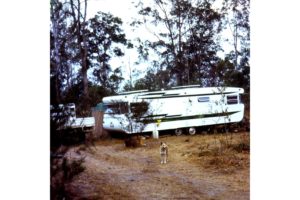
Unknowingly, I had always had an artistic, innovative creative side from my farming background. I could pictorially visualise things in detail long before they were constructed. That I understand is a special gift in life. I had grown up in the rainforest country of Wilson’s Creek, up in the mountains out from Mullumbimby, Northern New South Wales. This meant I had developed a special affinity to nature and the natural environment. My father had taught me by example, how to make things from the bare minimum of scrap, to turn unwanted scraps into useful items He had come through the Depression days of the 1930’s. This was recycling things long before recycling was a fashionable term. I had put this knowledge into good effect in the building of the future house.
Our property of five acres has many eucalypt trees on it with some areas of open space. See the photos below.
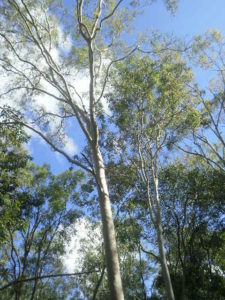
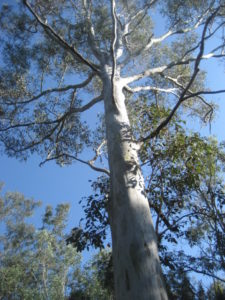
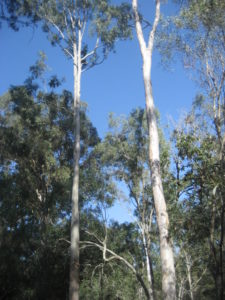
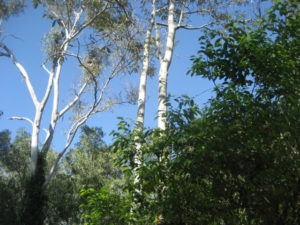
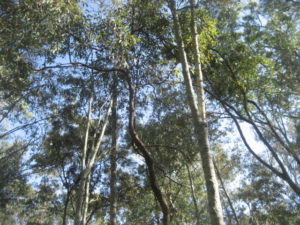
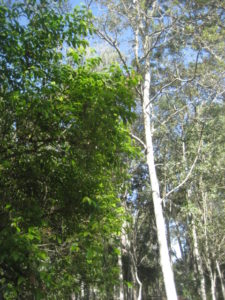
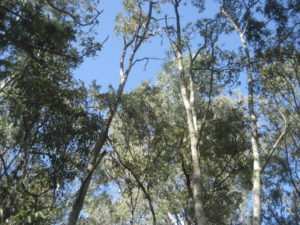
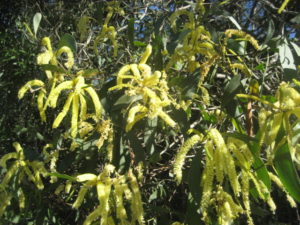
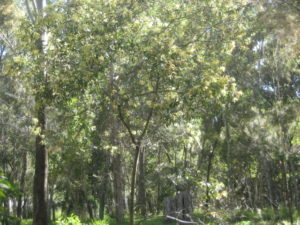
Acacia trees in flower in September which is the start of Spring in Australia.
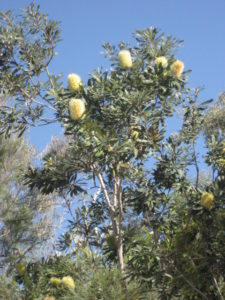
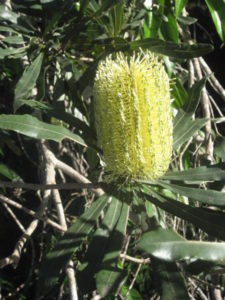
Among the many eucalypt trees, there is a small banksia tree …. Banksia integrifolia. This normally is a coastal banksia on the sand dunes on the sea. However, it grows very well on our land as we have very sandy soil.
Our land is on a sandstone base four metres down below the soil surface. We have on our land about a metre of black sandy topsoil which becomes a heavy clay layer which then goes down to the sandstone base. With heavy rain, the water sinks down to the heavy clay layer and sits on top of the clay. It is like a vast underground dam and with a slight southern slope of the land, this underground water slowly drains down the slope over several months. Three months later, this water is readily available at the surface if you dig a hole. Woe to you if you went down in a vehicle. The soil would turn to instant bog and you would need to be towed out by another vehicle on a firm surface (that is why we had many horizontal logs and branches laid down in our extensive driveway coming down to our house).
When the heavy clay layer is broken into, this underground water trickles out and down to fill any depression in the clay base below. It then becomes free water with an extensive surface. This is why we have some big ponds around our house.
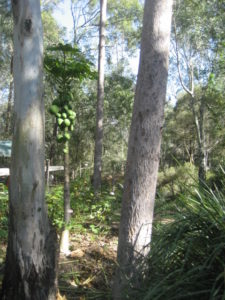
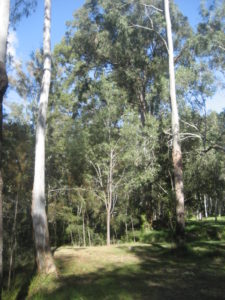
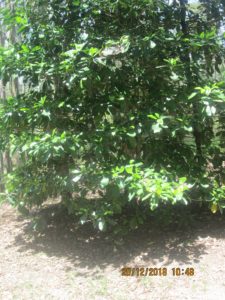
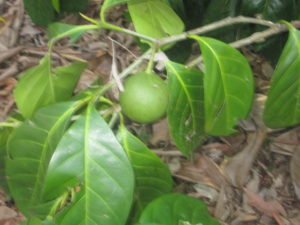
Native Gardenia called Randia Fitzalanii
I planted three trees around the property in the late 1980’s. These were the small native rainforest tree, the Native Gardenia called Randia Fitzalanii …. see the many images of the tree. It grows as a woody shrub or small tree some 3–10 m (9.8–32.8 ft) in height.
The trunk is covered by smooth grey bark. The large glossy dark green leaves are obovate to oval-shaped and range from 10–18 cm (3.9–7.1 in) long by 3–5 cm (1.2–2.0 in) wide. The yellowish veins and midribs are prominent on the leaf. The new growth is a bright lime green in colour. The small (2-2.5 cm or 1 inch) white fragrant flowers appear from September to November, occur singly and have five lanceolate petals around a tube. The round or oval-shaped fruit is 3–4 cm. in diameter and ripens in April to June. The fragrance of the flowers resembles that of the common gardenia, and fruit can be eaten fresh.
I had an interesting experience earlier this year in 2016 (now September 2016). I wanted to grow from natural seed, Randia Fitzalanii …. see the Post 4: The Rainforest Garden Room. I wanted to grow quite a few (100 +) to plant around the boundaries of our property …. at the front along Chambers Flat Rd. and down our two side boundaries. Randia is an excellent screening tree because of the density of the tree. Earlier in the year, I retrieved several of the small yellow pear-shaped fruit. I extracted the small seeds and placed them in several big pots of the soil mix created from our own compost and sandy soil mix. Being placed in our nursery watering area, up came many Randia seedlings. These were then taken out and planted out in small 150 mm nursery pots. These then grew to 150 mm high.
Recently, at an appropriate time after a good rainy period, these were all planted along the front along Chambers Flat Rd. and down our two side boundaries. These will then grow into a continuous screen along Chambers Flat Rd. and down our two side boundaries. When we bought the property in 1977, foliage was quite thick but twenty-nine years on, the foliage has really thinned out. You are beginning the see the house down among the trees. Car lights are being seen as they drive along Chambers Flat Rd. at night.
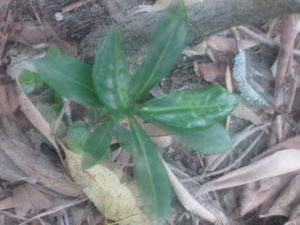
Seedling on our property of Native Gardenia called Randia Fitzalanii
As the Randia begin to grow over the next few years, they will begin to form an excellent screen as they have been planted about five meters apart. That means you do not see our house down among the trees and the two houses next door will not be seen as well.
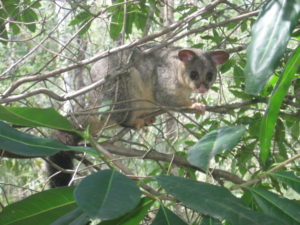
… Possum in the branches of a low growing rainforest tree in the middle of the day …. instead of the night when they come out …… I had planted this rainforest tree on the edge of our garden a few years ago …..
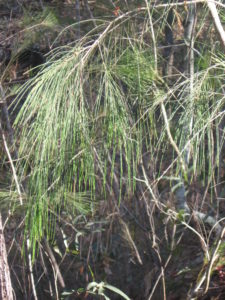
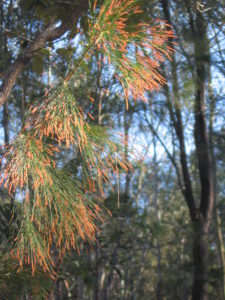
…. Casuarina littoralis or Black Oak is a small narrow tree between 6m and 15m high; bark persistent, rough, hard, dark grey/dark brown. Foliage is needle-like and branchlets are generally upright, the photosynthetic branchlets have a tiny reduced whorled teeth leaves 6 to 8 per segment. Flowering occurs in autumn through winter, male trees turn gold when laden with pollen. Female trees only bear the “cone” like fruit after small bright red flowers. The fruit is 10 to 30mm in length and flat-topped. Black Oaks may form dense stands in the absence of fire in bushland areas. We have many of these small trees on our land.
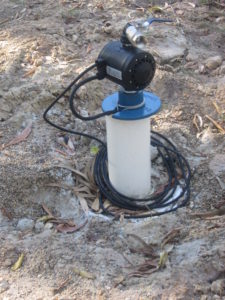
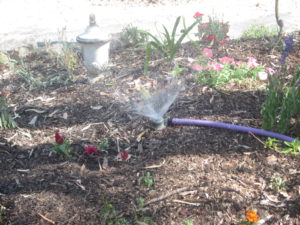
Since September 2015 we have put down a bore to 36 metres and struck abundant drinkable water. With a branching irrigation pipe, bore water can now be brought to taps on the topside and bottom side of our house. Sprinkling can be left in different areas for several hours at a time for minimal cost. Having abundant water for our garden, has greatly changed how we do gardening.
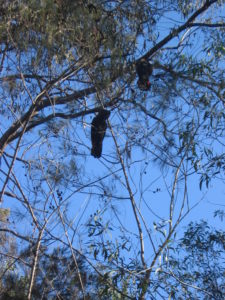
Red-tailed black cockatoo among the gum trees ….. The red-tailed black cockatoo also known as Banksian- or Banks’ black cockatoo, is a large black cockatoo native to Australia. Adult males have a characteristic pair of bright red panels on the tail that gives the species its name.
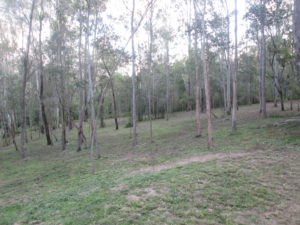
____________________________________________________________________________
Storm Lilies out in the Garden and on our Land:
In December 2018, we had three days of heavy rain. We have many Storm Lilies planted in our garden around the house. Storm Lilies are a beautiful lily to about 300 mm high and have a swirl of dull green narrow leaves. During dry times of the season, the lilies are just a swirl of dull green narrow leaves.
They respond very quickly to rain and within two days send up swelling pink flower heads. Within two more days, the swelling pink flower heads burst out as open expanding tubes of pink lily flowers. Suddenly from nowhere, there will be hundreds of beautiful lily flowers throughout the garden and down our driveway.
When we built the house in 1981, I suddenly found these pink-flowered lilies in a clump under some small trees coming down our extensive driveway. See the second top photograph below to see them in full flower after the rain in December. The lily bulbs are very easy to transplant into another location.
Within about a week of flowering, swelling heads of seeds develop which then break open to release many flat winged seeds within another week. These seeds then fall to the ground or blown by the wind to more distant areas. This is why Storm Lilies are in small clumps or single lilies out the middle of the lawn.
In December after the rain, there were hundreds of pink lily flowers out every wherein our extensive garden and down our driveway. In the garden, they are everywhere whereas, with our extensive driveway, I planted bulbs on either side of the driveway for viewing the flowers after rain.
Flowering can be several times a year after rain. It is wonderful when we come home or visitors come to our house and are greeted by hundreds of beautiful pink-flowered lilies. Our house as a hand-made house vs. machine built house is a very welcoming house. We have a huge community of people we relate to.
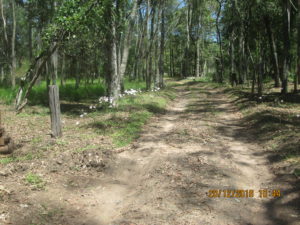
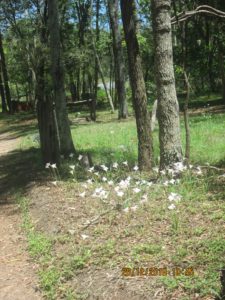
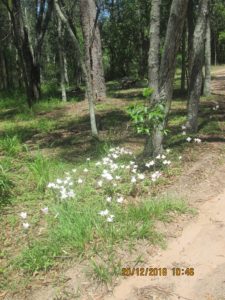
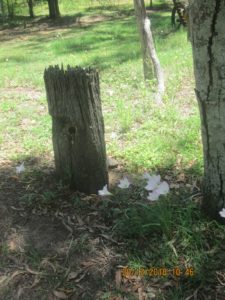
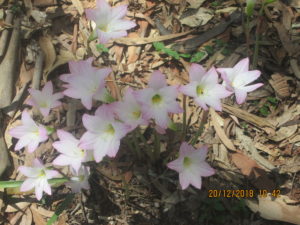
____________________________________________________________________________
Fog among our Trees on a Winter’s Morning:
The fog gives our land a deep sense of mystery …… you want to be led into it to explore more …. we love living here …. you never know what you are going to see:
- The sound and sighting of many birds …. see the Post 11: Animals and Birds on our Land
- Flowers coming out on the eucalypt trees which brings lots of rainbow lorikeets, flying foxes at night
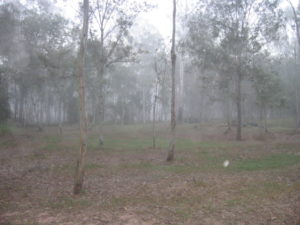
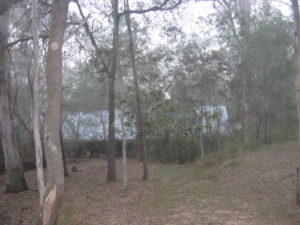
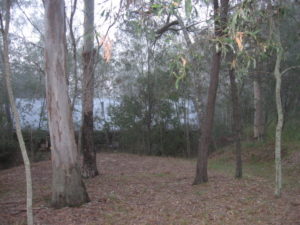
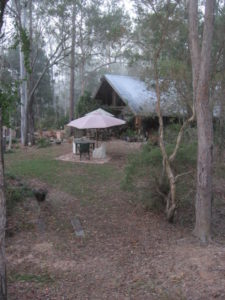
August 2019 at 6.30 am, in the morning. I am sitting in the arbour of our house. In late August it is warm enough to sit outside with a jumper on and enjoy looking out on our land. The mist is all through the trees and there are occasional drips of water from the trees from condensed moisture. There is also occasional sound and sighting of birds on our land which makes for the deep sense of the mystique of living here.
__________________________________________________________________________________
Small Dam:
Up the top of our land was a small dam which has now been filled and levelled for my Anthony, my son’s timber yard. We had a major problem with our long entry driveway down to our house from 1977 to the late 1980’s. Our land is on a sandstone base four metres down below the soil surface. We have on our land about a metre of black sandy topsoil which becomes a heavy clay layer which then goes down to the sandstone base. With heavy rain, the water sinks down to the heavy clay layer and sits on top of the clay. It is like a vast underground dam and with a slight southern slope of the land, this underground water slowly drains down the slope over several months. Three months later, this water is readily available at the surface if you dig a hole. Woe to you if you went down in a vehicle. The soil would turn to instant bog and you would need to be towed out by another vehicle on a firm surface.
In the late 1980’s I was in close contact with a landscape supplier through my landscape design and construction business I ran. This supplier said that he didn’t have a reliable source of sandy topsoil. I commented that our acreage land was on sandstone and we had a metre of sandy topsoil all over the top section. I arranged for him to come out and get as much as he wanted with his low loader. Instead of paying me for the number of cubic metres of soil, he could take it out in hours of machine work on our driveway …. a fair trade !!
He went further than I had anticipated. He dug out our driveway for about a 100 metres by taking out the topsoil to 300 mm deep. Then I laid many horizontal logs and branches in our extensive driveway coming down towards our house. Then he refilled the excavated topsoil area (placing the soil fill over the many horizontal logs and branches) with sandy clay excavated from the area he had been taking sandy topsoil from. This gave us a free shallow dam after he had left the site. This gave us occasionally a water-filled dam as per the photos below. The real benefit is that driveway was made totally solid with a very firm under base. Our driveway problem of potentially breaking through the sandy topsoil crust after heavy rain was totally solved. If we had broken through, we would be really bogged in a liquid mud.
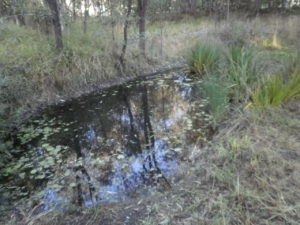
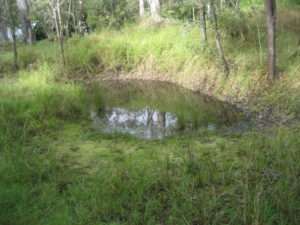
As of 2015, we do not need any water from the dam for our garden as we now have a good bore. Since September 2015 we have put down a bore to 36 metres and struck abundant drinkable water. With a branching irrigation pipe, bore water can now be brought to taps on the topside and bottom side of our house. Sprinkling can be left in different areas for several hours at a time for minimal cost. Having abundant water for our garden has greatly changed how we do gardening.
____________________________________________________________________________
Building the Car Shed in April 2008:
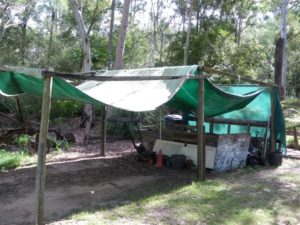
This was a temporary garage up until seven years ago in 2008 … It was a big tarp draped over a timber frame. It was a bit primitive but it kept birds from messing on the car or sticks falling off nearby trees and falling on the car. There was a temporary bulk storage area at the back.
About that time, our Landscape Design and Construction firm was a member of Bartercard. I had another member with a small excavator and hole-digging screw come to dig out eight deep holes for the placement of very big upright vertical posts for building on a permanent car shed. These were very big and had been stored at the top of the land for many years from a very old building that had been demolished in Brisbane. I was a good friend of a demolisher called Neil so I was always contra dealing favours on old timbers. Harriet (my wife) and I …. we love history and art. This explains why we built a house out of recycled timber and stone: THE HOUSE.
I had marked out the shape of the car shed in white lime on a flat area in the car park below the house so you could see it clearly. The small excavator dug out the marked holes for the car shed using a hole-digging screw. The operator then towed down the selected big square-shaped beams from my collection stored at the top of the land. He then carefully lifted these big beams and lowered them into the big holes about 2.00 meters deep. I then shoveled the dugout soil into the hole bit by bit and rammed it with a crowbar head over the next few weeks. The posts were kept vertical.
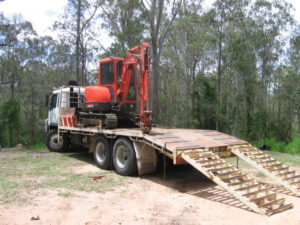
In later weeks, the excavator operator man came as part of his Barter Card work with two ladders, a plank to go between them and a chainsaw. He cut the big upright vertical posts at roof height, then he left. This meant I could then cut and fasten with big coach screws, horizontal timber boards around the car shed for future wall boarding. Years before I had arranged the pulling down and transportation of a very old settlers barn from Logan Reserve, an area near us. This old settlers barn was built of many big split slabs.
To obtain these slabs is a very rare thing. When settlers came out in the late 1880’s into the dry Australian bush, they wanted to clear the land of trees and create open space for their cattle. They split the trees with wedges to form timber slabs for a hut on their land. They also made post and rail fences, horizontal rails, and bigger posts to go in the ground. I had stored these slabs for many years up to one side our property where I had stored many pieces of demolition timber left over from the house when we built it in 1981. I carefully sorted these slabs out, wheeled them down 100 meters to the car shed, and began standing them vertically on a brick base to fill in the sides of the shed, drilling in big coach screws to hold them to the horizontal timber boards.
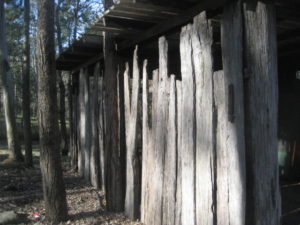
Because of my balance problems, I couldn’t build the roof. I had sustained a severe brain injury in December 1995 as a result of falling off a boogie-board in shallow surf at Peregian Beach on the Sunshine Coast of Queensland, Australia. Read my post:
About a year later, after the shed structure had been built, my brother Rick came to help build the roof. It was going to be my 60th Birthday (2009) next week and a lot of people were coming at night for a big party. We wanted to build the shed and properly house the car. Below are photos of my brother Rick building the roof.
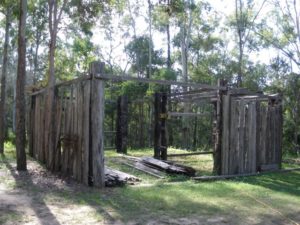
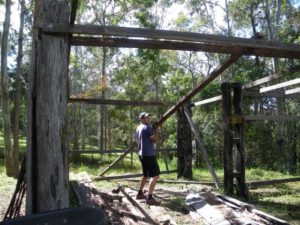
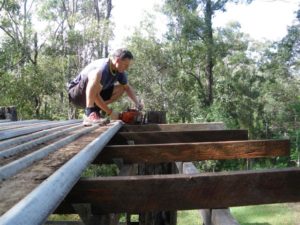
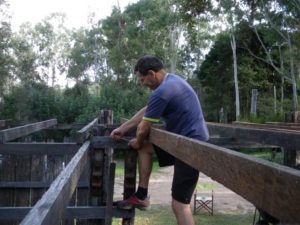
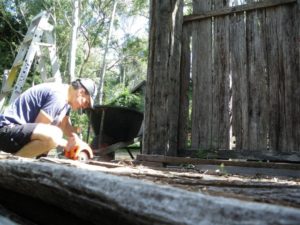
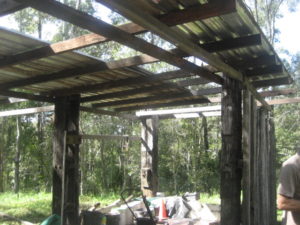
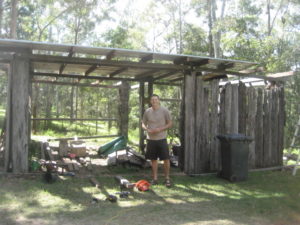
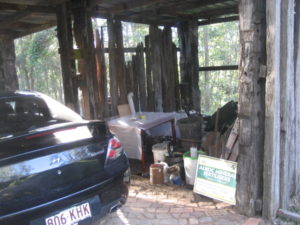
We had a weatherproof storage space and I brick paved the carport side for the car.
_____________________________________________________________________________
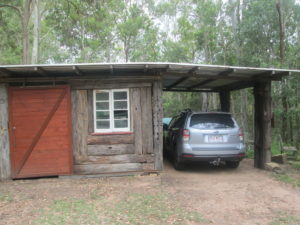
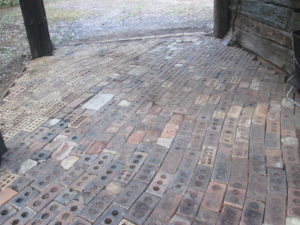
I have just completed on the 02.03.17 the paving in the car shed. I obtained these bricks free of cost from when my next-door neighbour’s house which had been built 40 ++ years ago. I like to curve my paving which gives an organic feel. Very little in nature consists of straight lines. It is only in the crystalline world where crystals form the structural component in rocks ….. the foundation of the Earth.
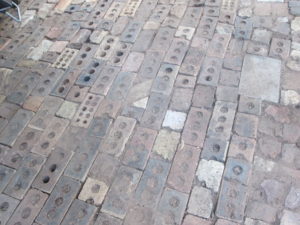
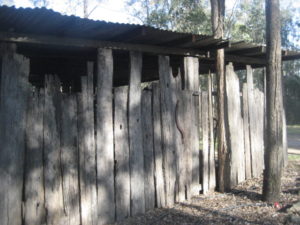
The sidewall built with many big split slabs.
____________________________________________________________________________
RECONSTRUCTION OF THE SHED TO MAKE A CREATIVE ROOM in August 2021
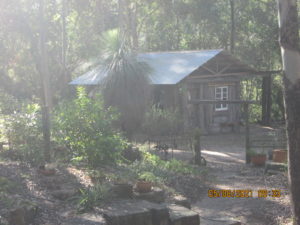

We wanted to create a special Creative Room in the shed. We had Shamgar (a work mate with Anthony, my son) and an offsider working on the reconstruction for a week.
We have been doing a whole shed and garage renovation in the last few days with Shamgar. See him at work on Anthony’s treehouse a few years ago inserted in the file below. We are converting the garage into a creative art room so that Harriet and I can work on creative projects. I do a lot of driftwood sculpturing. See this post: http://www.kenaitken.net/2-whole-garden/post-12-birdsnest-sculpturing/ The roof has been redone as a peaked roof with a sloped roof ….. It is just finished as of yesterday.
Some friends of ours who have practical wood skills carved out a section of sectioned log as Ken & Harriet’s Place as a gift to us. We have placed it above the window of the Creative Room in the shed. Big sheets of cut glass are going into the /\ apex of the peaked roof. That is the next project.
With Shamgar, Anthony and Harriet consulting together, they organised seven roof trusses to be delivered very cheaply from a local demolition yard. It was the same with the galvanised sheeting for the roof of the Creative Room. It was greatly reduced in price compared to new galvanised sheeting. It was good galvanised sheeting with only a few infrequent holes.
On north side (sunny side) of the Creative Room, Shamgar installed a big window we had onsite and a big sheet of glass from a demolished building. The glass lets in a lot of light into the Creative Room. When the cut glass goes into the /\ apex of the peaked roof, there will be even more light.
The sidewalls built with many big split slabs, makes the shed look as though it has been there. The big split slabs are a rarity. The split slabs were obtained from an old barn on farmland down the road at Logan Reserve, obtained in the late 1980’s. They were stored on our land till 2006 when the shed was built.
The open space on the right hand side of the shed is still our garage.
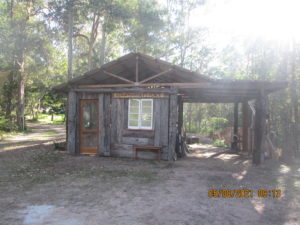

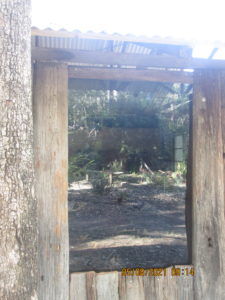
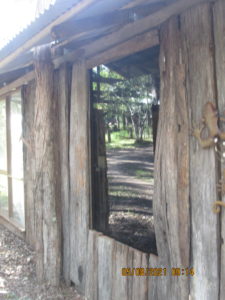
Big windows we had onsite and a big sheet of glass from a demolished building were placed on the northern side of the barn. The windows let in plenty of light.
____________________________________________________________________________
CREATIVE ROOM in action:
Several years ago, Anthony and Shamgar built a solid workbench ….. the one visible straight in front of the photo and shelves around the walls on the right-hand side of the room. They had stored for many years of leftovers and found things which I thought I might use one day. When the workbench and shelves had been built, they had been filled with small containers from an area up at the house from ten to twenty years ago.
The area was really a storage shed. To make it into a creative room, all to the stored material was taken outside to leave clean workbench and shelves and a brickpaved floor in curved lines with plenty of open space. It was agreed upon between Harriet and I as to which half of the work bench was mine and which area was hers.
I then brought about five wooden boxes of shells and driftwood I had collected since were at the little town of Deloraine in Tasmania. In November 2015, Harriet & I went on a two-week trip around Tasmania. We were going on a 42nd Wedding Anniversary of our honeymoon in December 1975. We had been married on the 9th December 1975 in Melbourne so it was only across Bass Strait on the ferry and we were in Tasmania.
When Harriet & I were on a two week trip around Tasmania in November 2015, we flew down to Hobart. We picked up this Britz Van as a camper van for two weeks and drove slowly around from East to West of Tasmania. We got to the little town of Deloraine and Harriet said we had to do shopping. She carefully parked the big camper van in the narrow street and said she was going down to Woolworth’s to do shopping. I then said I would read in the van ….. I didn’t want to go down to Woolworth’s.
When Harriet got out of the van, she called to me and said that I would love this gift and craft shop outside the van. I was interested as I have a great love of art and handmade things. I went into the shop with my camera and began ‘ooing’ and ‘aahing’ at all the things in the shop. One of the first things I saw was a three-dimensional piece of driftwood sculpture fastened on the wall. I took some camera shots and said to myself: “That is something I could do in the future at home”.
See the post: Post 12: Birdsnest Sculpturing
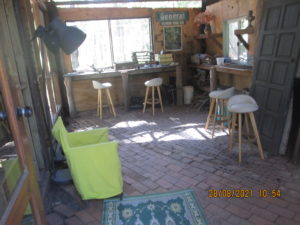
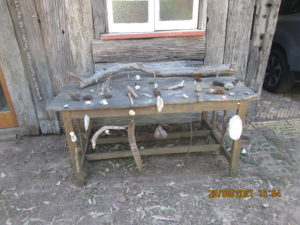
A work table outside with a big driftwood mobile ready to hang between two big trees coming down our driveway.
PLANT SURROUNDS:
I been making plant surrounds off limbs and branches of our property. Artistically, I love making them. Selecting branches so that they are thick or thin, straight or with a slight bend, whether smooth bark or rough bark, whether smooth bark or lichened surfaced, artistically, these considerations are very important. Even though the plant surrounds are unitarian, they are like big pieces of branch sculpture.
I can sell these on Facebook Market Place for at least $35.00 I am told. I will find out very soon when I start to market them. The potted plants will be sold to a standard nursery price …. if they are desired.
As of 2022, I have changed my mind on selling plant surrounds. Because we have a very large community of people around us, I have started giving them away to people who we are close to. This is with an understanding that they put a potted plant in the plant surrounds and place it in a prominent place. When they see it, they will see it as it as a signal of our community with us. The sense of community is far greater and more important than some dollars.
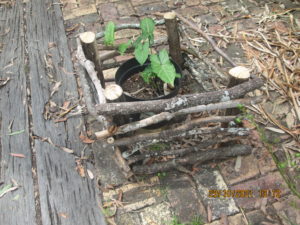
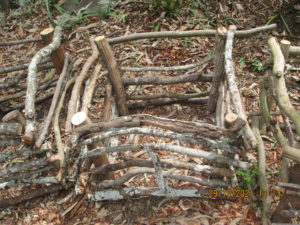
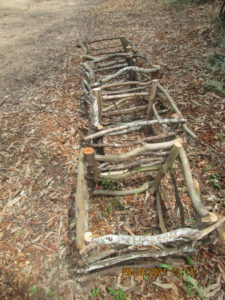
____________________________________________________________________________
ANTHONY, OUR SON, BUILDING ON OUR LAND …. 2016:
In July 2015, our 34-year-old son Anthony came to live with us again after ten years of being away. In 2016, he was still acting as a tour manager for firms that engaged him. These firms signed him up because they are bringing in international music bands into Australia. He had to work out all the tour details for each band. He is very detailed, practical, and organising …. he loves it!! He takes after his mother Harriet.
We all went to Melbourne in July 2015 to attend the funeral of Harriet’s mother Heather Kent. Heather was 97 years old and the funeral was packed out. There were even people there who Heather wouldn’t have seen for 20 years. Heather was a real family and friendship woman. Anthony was one of the pallbearers along with the grandsons. Anthony suddenly experienced the value of family. That is why Anthony has come to live with us again after ten years of being away. He has become very family orientated and wants to look after us in our later years. He has come to love and appreciate our house built from recycled materials. He has come to help build ‘The Aitken Legacy’ long term.
He has become very focused on tree houses and has a big tree down the back of our bush block land where he has built his own treehouse. He has formed the following:
- Treehouse Club on Facebook. In September 2016 he had 347 members and now in August 2021, he has 37,400 members. See the photos of completed treehouses from around the world.
- http://www.treehouseclub.net/ …… High In The Trees Since 2015. There are dozens of contributions from people around the world on building treehouses.
In November 2015, he flew over to Oregon, USA to meet Michael Garnier who has a whole business in building tree houses. He came back with a whole suitcase of special hinged bolts that he can use on a tree without hacking into the tree. He was getting very serious.
As I said before in a previous post, I had run my own business in Landscape Design and Construction for twenty years, doing very creative individual designer gardens for wealthy residential clients. I was more an artist than a businessman. I thought of a landscape as would a sculptor in a solid medium, but I saw it as a three-dimensional piece of space that people walked through. This space changed with time as it grew and changed with the time of day: shadows vs. sun patterns, boulders, colour, plants, trees, earth-forms, solid structures, and water. These were the ingredients I used. Unknowingly, I was a landscape sculptor. Rather an intangible product to sell and run a business with!! However, I built a structure for my life: my marriage, family, and business from this base.
Anthony has built many things around our house, like the raised garden beds in the Permaculture section of our extensive garden. See the Post 7: Permaculture Garden Room. Then he started building on the car shed. He said to us he would like to build a man cave where we had parked the car ….. could we park the car on the other side? A man cave is where he & I can build things together. Then Harriet waded in ….. she wanted a place to do some art. It has now become an art-house …. no gender is apparent.
He built over a several week period an entirely new façade on a light pine framework that incorporated an old recycled window. Then he filled in the wall with some of the split slabs in a horizontal position and some in vertical position …. very artistic. He then built a big barn door, hung on a horizontal steel rail off an old wheeled banana carrier I had since my banana-growing days at Wilsons Creek in the 1950’s and 1960s.
Harriet and I am very proud of what our son has accomplished.
__________________________________________________________________________
ANTHONY’S TIMBER YARD ON OUR LAND …. 2021:
Anthony built a Timber Yard on our land after he finished building the mid-deck of his treehouse as of April 2018. See the post: ANTHONY, OUR SON, BUILDING HIS TREEHOUSE ON OUR LAND
____________________________________________________________________________
Photos of the Timber Yard:
Logs in the Yard
Logs ready to be cut up
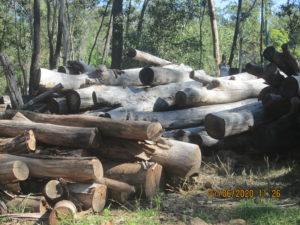
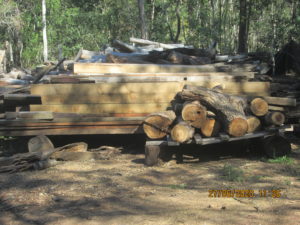
The small cut logs on the right-hand which are stacked up are red cedar logs …. a very rare rainforest timber. Anthony organised a deal with someone way up at Maleny. He brought down a truckload of this timber plus two ute loads.
The non-stacked logs are hoop pine logs …. this too, a rare rainforest timber.
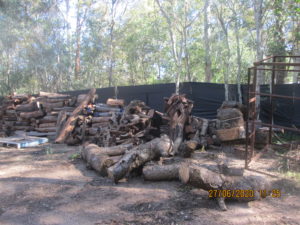
__________________________________________________________________________________________
Flitches Ready For Sale ( as of mid 2020):
The small cut timbers have special qualities to made into coffee tables etc. by clients.
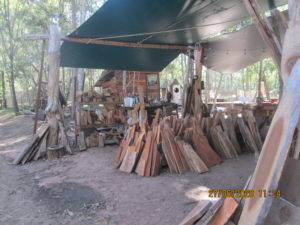
Cut flitches used by clients for outdoor table tops etc.
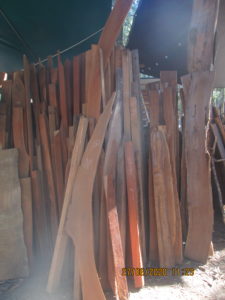
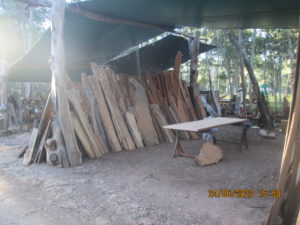
Cut timber drying and weathering in the open air. Anthony separates the slabs by small sawn square-cut rods which allows air to circulate between the many slabs.
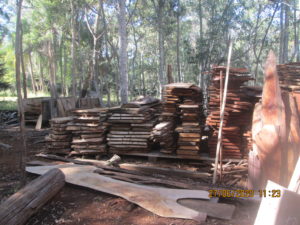
The big tarpaulin keeps the rain off the seasoned timber and keeps the dirt floor dry on a wet day.

The driveway goes up to a set of gates that can be opened onto Chambers Flat road whereby customers can drive straight into the yard. A black screen seals of the yard from the road.
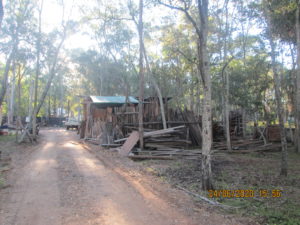
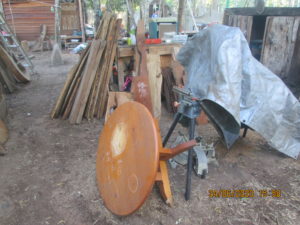
______________________________________________________________________________
The Cabin He Now Lives In:
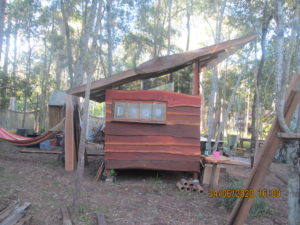

____________________________________________________________________
Building The New Kitchen as of June 2020:
Anthony and Shamgar (a working mate of Anthony), have been building this new building as a kitchen to his cabin. As he has been building this structure, he has realised that it offers more room than his cabin for living in. With this perception, he has changed his mind. This will be his new living space and his present cabin will be his kitchen.
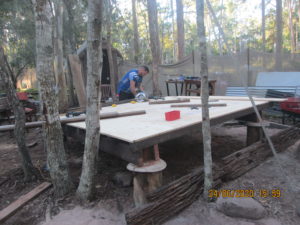


The building has blue waterproof sarking on the walls. Timber weatherboards are to added as the next stage. More photos to follow.
____________________________________________________________________
My Past Landscape & Design Business:
I used to have a little landscape design office upstairs as I discussed in the note on building the staircase in the house post. I was designing and constructing these sort of jobs:
Then I moved into a downstairs office so my growing son could turn the office into a bedroom for himself and to build an office for himself in the first room immediately above the staircase. He began running his own business.
Having run for twenty years the small Landscape Design and Construction business, I went through a life-changing situation. In December 1995, I sustained a very severe brain injury by falling off a boogie-board in shallow surf at Peregian Beach on the Sunshine Coast of Queensland, Australia. Consequently, I was in a coma for four weeks, confined in the hospital for six months, had to learn everything all over again. These things included:
- Had to learn everything all over again including walking, talking and eating solid food again
- Get my brain back together from a very scrambled state since December 1995. I am not the same man as before my accident
- Lost a lot of intuitive ability to feel what other people are saying ….. although that has largely come back now
- I am not the same man as before my accident. However, I have learned to work from what I have and not what I have lost. It is a new season in my life
- I cannot drive twenty-five years (from 2020) years out from my accident …. but I have learned to drive on the Internet …. to go around the world in few minutes and see hundreds of people at the same time
See the post: A life-changing situation for my fuller story.
In the last two years, our 36-year-old son Anthony has come to live with us again after ten years of being away. He has acted as a tour manager for firms that engage him. These firms would sign him up because they are bringing in international music bands into Australia. He has to work out all the tour details for each band. He is very detailed, practical, and organising …. he loves it!! He takes after his mother Harriet.
We all went to Melbourne in July 2015 to attend the funeral of Harriet’s mother Heather Kent. Heather was 97 years old and the funeral was packed out. There were even people there who Heather wouldn’t have seen for 20 years. Heather was a real family and friendship woman. Anthony suddenly experienced the value of family. That is why Anthony has come to live with us again after ten years of being away. He has become very family orientated and wants to look after us in our later years. He has come to love and appreciate our house built from recycled materials. He has come to help build ‘The Aitken Legacy’ long term. He is now full of new ideas.
He has become very focused on tree houses and has a big tree down the back of our bush block land where he is has built his treehouse. He has formed a Treehouse Club on Facebook. In September 2016 he had 347 members and now in August 2021, he has 37,400 members. See the post:
ANTHONY, OUR SON, BUILDING HIS TREEHOUSE ON OUR LAND
to see his completed tree house and showing the building process.
In November 2015, he flew over to Oregon, USA to meet Michael Garnier who has a whole business in building tree houses. He came back with a whole suitcase of special hinged bolts that he can use on a tree without hacking into the tree. He was getting very serious.
________________________________________________________________________________________
